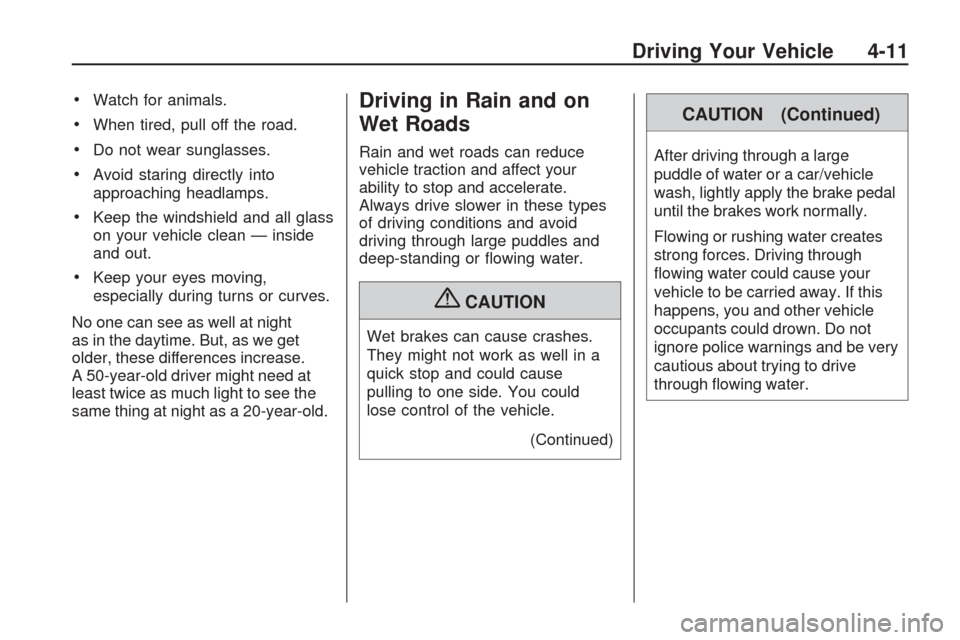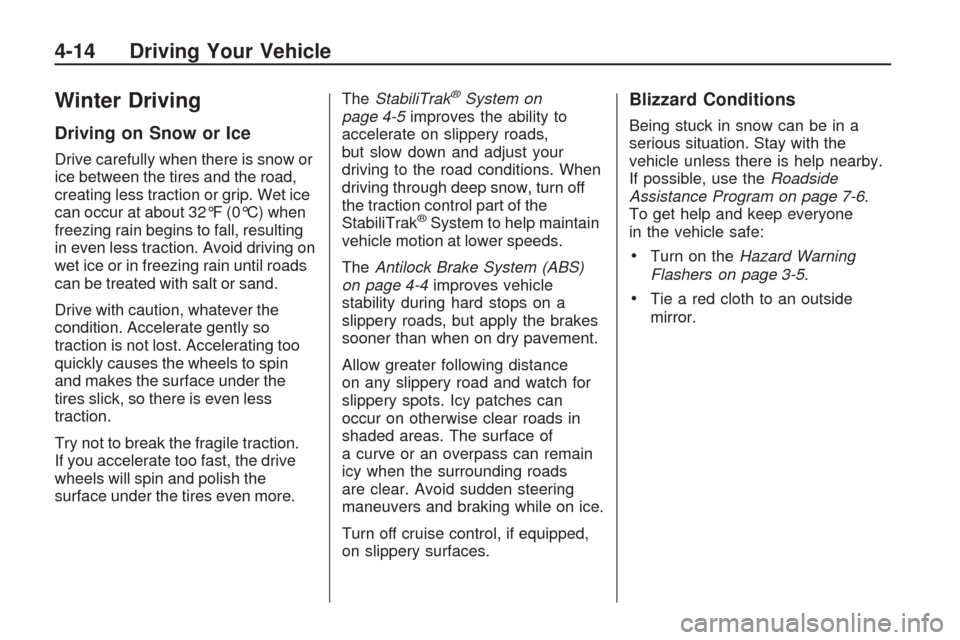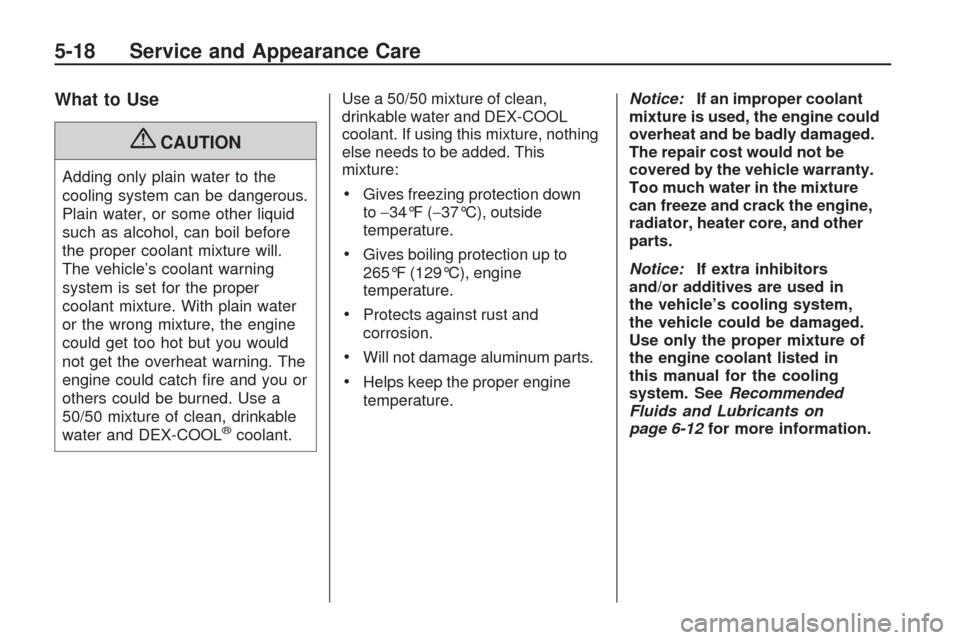2009 CHEVROLET TRAVERSE warning
[x] Cancel search: warningPage 259 of 422

Watch for animals.
When tired, pull off the road.
Do not wear sunglasses.
Avoid staring directly into
approaching headlamps.
Keep the windshield and all glass
on your vehicle clean — inside
and out.
Keep your eyes moving,
especially during turns or curves.
No one can see as well at night
as in the daytime. But, as we get
older, these differences increase.
A 50-year-old driver might need at
least twice as much light to see the
same thing at night as a 20-year-old.
Driving in Rain and on
Wet Roads
Rain and wet roads can reduce
vehicle traction and affect your
ability to stop and accelerate.
Always drive slower in these types
of driving conditions and avoid
driving through large puddles and
deep-standing or �owing water.
{CAUTION
Wet brakes can cause crashes.
They might not work as well in a
quick stop and could cause
pulling to one side. You could
lose control of the vehicle.
(Continued)
CAUTION (Continued)
After driving through a large
puddle of water or a car/vehicle
wash, lightly apply the brake pedal
until the brakes work normally.
Flowing or rushing water creates
strong forces. Driving through
�owing water could cause your
vehicle to be carried away. If this
happens, you and other vehicle
occupants could drown. Do not
ignore police warnings and be very
cautious about trying to drive
through �owing water.
Driving Your Vehicle 4-11
Page 262 of 422

Winter Driving
Driving on Snow or Ice
Drive carefully when there is snow or
ice between the tires and the road,
creating less traction or grip. Wet ice
can occur at about 32°F (0°C) when
freezing rain begins to fall, resulting
in even less traction. Avoid driving on
wet ice or in freezing rain until roads
can be treated with salt or sand.
Drive with caution, whatever the
condition. Accelerate gently so
traction is not lost. Accelerating too
quickly causes the wheels to spin
and makes the surface under the
tires slick, so there is even less
traction.
Try not to break the fragile traction.
If you accelerate too fast, the drive
wheels will spin and polish the
surface under the tires even more.TheStabiliTrak
®System on
page 4-5improves the ability to
accelerate on slippery roads,
but slow down and adjust your
driving to the road conditions. When
driving through deep snow, turn off
the traction control part of the
StabiliTrak
®System to help maintain
vehicle motion at lower speeds.
TheAntilock Brake System (ABS)
on page 4-4improves vehicle
stability during hard stops on a
slippery roads, but apply the brakes
sooner than when on dry pavement.
Allow greater following distance
on any slippery road and watch for
slippery spots. Icy patches can
occur on otherwise clear roads in
shaded areas. The surface of
a curve or an overpass can remain
icy when the surrounding roads
are clear. Avoid sudden steering
maneuvers and braking while on ice.
Turn off cruise control, if equipped,
on slippery surfaces.
Blizzard Conditions
Being stuck in snow can be in a
serious situation. Stay with the
vehicle unless there is help nearby.
If possible, use theRoadside
Assistance Program on page 7-6.
To get help and keep everyone
in the vehicle safe:
Turn on theHazard Warning
Flashers on page 3-5.
Tie a red cloth to an outside
mirror.
4-14 Driving Your Vehicle
Page 283 of 422

Service and
Appearance Care
ServiceService................................5-3
Accessories and
Modi�cations.......................5-3
California Proposition 65
Warning.............................5-4
California Perchlorate
Materials Requirements........5-4
Doing Your Own
Service Work......................5-4
Adding Equipment to the
Outside of the Vehicle...........5-4
FuelFuel....................................5-5
Gasoline Octane...................5-5
Gasoline Speci�cations..........5-5
California Fuel......................5-5
Additives..............................5-5
Fuels in Foreign Countries......5-6
Filling the Tank.....................5-7
Filling a Portable Fuel
Container...........................5-8
Checking Things Under
the Hood
Checking Things Under
the Hood............................5-9
Hood Release.......................5-9
Engine Compartment
Overview..........................5-10
Engine Oil..........................5-11
Engine Oil Life System.........5-13
Engine Air Cleaner/Filter.......5-15
Automatic Transmission
Fluid................................5-16
Cooling System...................5-17
Engine Coolant...................5-17
Engine Overheating.............5-22
Overheated
Engine Protection
Operating Mode.................5-23
Power Steering Fluid............5-24
Windshield Washer Fluid......5-24
Brakes...............................5-25
Battery...............................5-28
Jump Starting.....................5-29
Headlamp AimingHeadlamp Aiming................5-33
Bulb ReplacementBulb Replacement...............5-33
Halogen Bulbs....................5-33
Taillamps, Turn Signal,
Stoplamps and
Sidemarker Lamps.............5-33
Replacement Bulbs..............5-34
Windshield Wiper Blade
Replacement
Windshield Wiper Blade
Replacement.....................5-35
TiresTires..................................5-36
Tire Sidewall Labeling..........5-37
Tire Terminology and
De�nitions.........................5-39
In�ation - Tire Pressure........5-42
Tire Pressure Monitor
System.............................5-43
Tire Pressure Monitor
Operation..........................5-45
Tire Inspection and
Rotation............................5-48
When It Is Time for New
Tires................................5-50
Buying New Tires................5-50
Service and Appearance Care 5-1
Page 286 of 422

California Proposition 65
Warning
Most motor vehicles, including this
one, contain and/or emit chemicals
known to the State of California
to cause cancer and birth defects or
other reproductive harm. Engine
exhaust, many parts and systems
(including some inside the vehicle),
many �uids, and some component
wear by-products contain and/or
emit these chemicals.
California Perchlorate
Materials Requirements
Certain types of automotive
applications, such as airbag
initiators, seat belt pretensioners,
and lithium batteries contained in
remote keyless transmitters, may
contain perchlorate materials.
Special handling may be necessary.
For additional information, see
www.dtsc.ca.gov/hazardouswaste/
perchlorate.
Doing Your Own
Service Work
{CAUTION
You can be injured and the
vehicle could be damaged if you
try to do service work on a vehicle
without knowing enough about it.
Be sure you have sufficient
knowledge, experience, the
proper replacement parts, and
tools before attempting any
vehicle maintenance task.
Be sure to use the proper
nuts, bolts, and other
fasteners. English and metric
fasteners can be easily
confused. If the wrong
fasteners are used, parts
can later break or fall off.
You could be hurt.
If doing some of your own service
work, use the proper service
manual. It tells you much moreabout how to service the vehicle
than this manual can. To order the
proper service manual, see
Service Publications Ordering
Information on page 7-15.
This vehicle has an airbag system.
Before attempting to do your
own service work, seeServicing
Your Airbag-Equipped Vehicle
on page 1-57.
Keep a record with all parts receipts
and list the mileage and the date
of any service work performed. See
Maintenance Record on page 6-16.Adding Equipment to the
Outside of the Vehicle
Things added to the outside of
the vehicle can affect the air�ow
around it. This can cause wind noise
and can affect fuel economy and
windshield washer performance.
Check with your dealer/retailer
before adding equipment to
the outside of the vehicle.
5-4 Service and Appearance Care
Page 297 of 422

If the vehicle has Driver Information
Center (DIC) buttons:
1. Turn the ignition to ON/RUN,
with the engine off.
2. Press the vehicle information
button until OIL LIFE
REMAINING displays.
3. Press and hold the set/reset
button until 100% is displayed.
Three chimes sound and
the CHANGE ENGINE OIL
SOON message goes off.
4. Turn the key to LOCK/OFF.
If the CHANGE ENGINE OIL SOON
message comes back on when the
vehicle is started, the engine oil life
system has not reset. Repeat the
procedure.What to Do with Used Oil
Used engine oil contains certain
elements that can be unhealthy for
your skin and could even cause
cancer. Do not let used oil stay on
your skin for very long. Clean your
skin and nails with soap and water,
or a good hand cleaner. Wash or
properly dispose of clothing or rags
containing used engine oil. See the
manufacturer’s warnings about the
use and disposal of oil products.
Used oil can be a threat to the
environment. If you change your own
oil, be sure to drain all the oil from the
�lter before disposal. Never dispose
of oil by putting it in the trash, pouring
it on the ground, into sewers, or into
streams or bodies of water. Recycle
it by taking it to a place that collects
used oil.
Engine Air Cleaner/Filter
When to Inspect the Engine
Air Cleaner/Filter
Inspect the air cleaner/�lter at the
MaintenanceIIintervals and replace
it at the �rst oil change after each
50,000 mile (80 000 km) interval.
SeeScheduled Maintenance on
page 6-3for more information. If you
are driving in dusty/dirty conditions,
inspect the �lter at each engine oil
change.
SeeEngine Compartment Overview
on page 5-10for the location of
the engine air cleaner/�lter.
How to Inspect the Engine Air
Cleaner/Filter
To inspect the air cleaner/�lter,
remove the �lter from the vehicle and
lightly shake the �lter (away from
vehicle) to release loose dust and
dirt. If the �lter remains caked with
dirt, a new �lter is required.
Service and Appearance Care 5-15
Page 300 of 422

What to Use
{CAUTION
Adding only plain water to the
cooling system can be dangerous.
Plain water, or some other liquid
such as alcohol, can boil before
the proper coolant mixture will.
The vehicle’s coolant warning
system is set for the proper
coolant mixture. With plain water
or the wrong mixture, the engine
could get too hot but you would
not get the overheat warning. The
engine could catch �re and you or
others could be burned. Use a
50/50 mixture of clean, drinkable
water and DEX-COOL
®coolant.Use a 50/50 mixture of clean,
drinkable water and DEX-COOL
coolant. If using this mixture, nothing
else needs to be added. This
mixture:
Gives freezing protection down
to−34°F (−37°C), outside
temperature.
Gives boiling protection up to
265°F (129°C), engine
temperature.
Protects against rust and
corrosion.
Will not damage aluminum parts.
Helps keep the proper engine
temperature.Notice:If an improper coolant
mixture is used, the engine could
overheat and be badly damaged.
The repair cost would not be
covered by the vehicle warranty.
Too much water in the mixture
can freeze and crack the engine,
radiator, heater core, and other
parts.
Notice:If extra inhibitors
and/or additives are used in
the vehicle’s cooling system,
the vehicle could be damaged.
Use only the proper mixture of
the engine coolant listed in
this manual for the cooling
system. SeeRecommended
Fluids and Lubricants on
page 6-12for more information.
5-18 Service and Appearance Care
Page 304 of 422

Engine Overheating
The vehicle has several indicators
to warn of engine overheating.
There is an engine coolant
temperature gage on the instrument
panel cluster. SeeEngine Coolant
Temperature Gage on page 3-38.
The vehicle may also display
an ENGINE OVERHEATED
IDLE ENGINE and ENGINE
OVERHEATED STOP ENGINE
message in the Driver Information
Center (DIC). SeeDIC Warnings and
Messages on page 3-56.
You may decide not to lift the hood
when this warning appears, but
instead get service help right away.
SeeRoadside Assistance Program
on page 7-6.
If you do decide to lift the hood,
make sure the vehicle is parked
on a level surface.Then check to see if the engine
cooling fans are running. If the
engine is overheating, both fans
should be running. If they are
not, do not continue to run the
engine and have the vehicle
serviced.
Notice:Engine damage from
running the engine without
coolant is not covered by the
warranty.
Notice:If the engine catches �re
while driving with no coolant,
the vehicle can be badly
damaged. The costly repairs
would not be covered by
the vehicle warranty. See
Overheated Engine Protection
Operating Mode on page 5-23for
information on driving to a
safe place in an emergency.
If Steam Is Coming From The
Engine Compartment
{CAUTION
Steam from an overheated engine
can burn you badly, even if you
just open the hood. Stay away
from the engine if you see or hear
steam coming from it. Turn it off
and get everyone away from the
vehicle until it cools down. Wait
until there is no sign of steam or
coolant before you open the hood.
If you keep driving when the
vehicles engine is overheated, the
liquids in it can catch �re. You or
others could be badly burned.
Stop the engine if it overheats,
and get out of the vehicle until the
engine is cool.
SeeOverheated Engine Protection
Operating Mode on page 5-23for
information on driving to a safe
place in an emergency.
5-22 Service and Appearance Care
Page 305 of 422

If No Steam Is Coming From
The Engine Compartment
If an engine overheat warning is
displayed but no steam can be seen
or heard, the problem may not be
too serious. Sometimes the
engine can get a little too hot when
the vehicle:
Climbs a long hill on a hot day.
Stops after high-speed driving.
Idles for long periods in traffic.
Tows a trailer.
If the overheat warning is displayed
with no sign of steam:
1. Turn the air conditioning off.
2. Turn the heater on to the highest
temperature and to the highest
fan speed. Open the windows as
necessary.3. If in a traffic jam, shift to
N (Neutral), otherwise, shift
to the highest gear while
driving —D (Drive) or L (Low).
If the temperature overheat gage is
no longer in the overheat zone or an
overheat warning no longer displays,
the vehicle can be driven. Continue
to drive the vehicle slow for about
10 minutes. Keep a safe vehicle
distance from the car in front of you.
If the warning does not come back
on, continue to drive normally.
If the warning continues, pull over,
stop, and park the vehicle right away.
If there is no sign of steam, idle
the engine for three minutes while
parked. If the warning is still
displayed, turn off the engine until it
cools down. Also, see “Overheated
Engine Protection Operating Mode”
next in this section.
Overheated
Engine Protection
Operating Mode
This emergency operating mode lets
the vehicle be driven to a safe place
in an emergency situation. If an
overheated engine condition exists,
an overheat protection mode which
alternates �ring groups of cylinders
helps prevent engine damage. In this
mode, there is a signi�cant loss in
power and engine performance.
The temperature gage indicates an
overheat condition exists. Driving
extended distances and/or towing a
trailer in the overheat protection
mode should be avoided.
Notice:After driving in the
overheated engine protection
operating mode, to avoid engine
damage, allow the engine to cool
before attempting any repair.
The engine oil will be severely
degraded. Repair the cause of
coolant loss, change the oil and
reset the oil life system. See
Engine Oil on page 5-11.
Service and Appearance Care 5-23